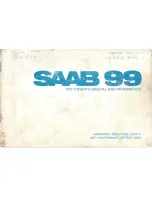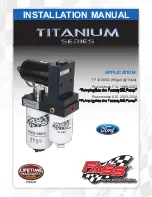
129
www.factoryfive.com
508-291-3443
Refer to appendix A for a drawing on how to make a wooden buck to hold the body. A body buck
diagram is in the appendix. The dimensions do not have to be exact. A rough shape is all that is needed
to hold the body.
TOOLS: 8
0, 220, 400 grit sand paper, sanding blocks.
1.
Remove all trim, doors, windshield etc. before beginning body work
2.
Take extra care to sand away the fibers and strands specifically around the roll bar area. Finished
flange around door should not exceed ½” to make sure the press-on door trim fits.
3.
The primer gel coat sands easily, and is a forgiving material to work with. Remember that the body
comes out of the mold with a wax release compound and a thorough cleaning with a wax remover is
the best way to begin this job. After the body is cleaned you can begin the sanding steps.
4.
The parting lines are easiest to remove with a file or scrapper (these are the lines where the mold
comes apart). For a car that will be painted a dark color such as black or dark blue it is very important
to understand the nature of fiberglass as a material. The vinyl ester resins used for these bodies will
shrink with a final stage of curing with the elevated temperatures that are present in the sun on a dark
car. The parting seams and any area of body filler repair should be given at LEAST several days to
cure. If you want to heat cure the bodies do not exceed 140° F. When the final paint is applied it is
very smart to add several coats of clear to those areas where work was done so that years later you or
the next owner can simply sand out and buff any imperfections that may develop.
5.
Much time and energy was spent on the mold so that the parts line up evenly and don’t have a
different height when you begin sanding. Take your time at this final fitting stage and you’ll be
rewarded with a fine finish, and a perfectly straight body. Of all the areas to be a perfectionist this is
the one.
6.
Block sand the entire body surface with 80 grit sandpaper. For flat sections you can use a harder
rubber sanding block. For curved sections, use a firm sponge at an angle to the curve that you are
sanding.
7.
Make sure the body is clean and grease/wax free before priming.
8.
Allow the bodywork or repairs performed to sit for several days outside in the sun or at elevated
temperatures to allow the repair materials to cure.
9.
Prime the body surface with a polyester primer/surfacer such as featherfill. Make sure you prime with
a polyester primer over all areas of repair. This polyester primer is the same chemical base as gel coat
and acts as a barrier between the raw fiberglass and the topcoat you will be applying.
10.
Block sand with 220 grit paper.
11.
The last coat of primer should be a different color so that you can see scratches or flaws that were
missed the first time around. Pay particular attention to the areas on the top of the car since these are
the most visible to the person looking at the car.
12.
After the primer is dry, use a 400-grit wet sanding paper with wet sponge soaked frequently to finish
the surface preparation. You will see the heavier 220 grit scratches in the surface you are sanding
with 400 grit and you want to sand until these heavier scratches are gone.
13.
While you’re wet sanding, you know you’re finished with an area when it appears foggy and water
doesn’t bead up on the surface. Wipe the area with a flat squeegee while sanding to inspect the surface
for defects.
14.
Spray a sealer coat over the primer and follow this with your first paint coats. The modern two stage
basecoat/clear coat urethanes are the best choice since they offer the workability of the lacquer paints
with the flexibility and resistance to cracking of the enamels. The clear coat should be fairly thick
since you can repair this layer in the future if something happens to the cars finish. We’ve seen bad
looking scratches repaired if the scratch didn’t pass through the clear.
15.
Go slow. It is amazing how many people (including us) rush the last steps in order to get the paint on
the body when only a few more hours would give you a show car. Keep in mind that paint is
Summary of Contents for Mk3 Roadster
Page 1: ...i www factoryfive com 508 291 3443...
Page 10: ...10 www factoryfive com 508 291 3443 Chapter 1 Donor Parts and Parts Needed...
Page 38: ...38 www factoryfive com 508 291 3443 Chapter 2 Step By Step Chassis Build up...
Page 100: ...100 www factoryfive com 508 291 3443 Engine harness plug mounted in firewall...
Page 199: ...199 www factoryfive com 508 291 3443 Appendix A Templates...
Page 200: ...200 www factoryfive com 508 291 3443...
Page 201: ...201 www factoryfive com 508 291 3443...
Page 202: ...202 www factoryfive com 508 291 3443...
Page 203: ...203 www factoryfive com 508 291 3443...
Page 204: ...204 www factoryfive com 508 291 3443...
Page 205: ...205 www factoryfive com 508 291 3443...
Page 206: ...206 www factoryfive com 508 291 3443...
Page 209: ...209 www factoryfive com 508 291 3443...
Page 211: ...211 www factoryfive com 508 291 3443 Appendix B Donor Parts List...
Page 214: ...214 www factoryfive com 508 291 3443 Appendix C Roadster Standard Pack list...
Page 227: ...227 www factoryfive com 508 291 3443 Appendix D Big Block Instructions...
Page 236: ...236 www factoryfive com 508 291 3443 Appendix E 3 Link Instructions...
Page 242: ...242 www factoryfive com 508 291 3443...
Page 245: ...245 www factoryfive com 508 291 3443 Appendix F Independent Rear Suspension...
Page 267: ...267 www factoryfive com 508 291 3443 Appendix G Torque specifications...
Page 269: ...269 www factoryfive com 508 291 3443 Appendix H Mustang Specifications...
















































